| * Department of Vocal Music (Odissi Vocal & Hindustan Vocal) |
* Department of Instrumental Music (Odishi Pakhwaj , Tabla, Flute, Hindustani Violin, & Sitar) |
| * Department of Dance (Odissi Dance & Chhow Dance) |
* Department of Drama (Stage Craft, Acting & Direction) |
|
| |
| * Department of Vocal Music |
Odissi Vocal Music
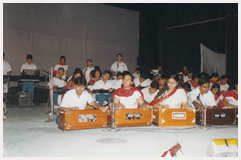 Classical Indian music is broadly classified into two – Hindustani and Karnataki Classical. This divides India into two North and South respectively. Eastern India has its own form of music which is found in Odisha named as Odissi Music. This has its own Ragas, Gayaki and Tala systems, that is second to none. Odissi music is based on Bhara. The system is imprinted in the Gita-Gobinda of Jayadeva where specific Tala and Ragas are prescribed which is according to Odissi. Classical Indian music is broadly classified into two – Hindustani and Karnataki Classical. This divides India into two North and South respectively. Eastern India has its own form of music which is found in Odisha named as Odissi Music. This has its own Ragas, Gayaki and Tala systems, that is second to none. Odissi music is based on Bhara. The system is imprinted in the Gita-Gobinda of Jayadeva where specific Tala and Ragas are prescribed which is according to Odissi.
* Hindustani Vocal Music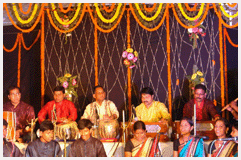
In India music is a popular art where traditional, tribal. and classical music can been seen The term classical pertains to aesthetic music. Hindustani vocal music belongs to North India. For all practical purposes it can be named as Raga Music. Classical music has its own classification of singing patterns and rhythm. Hindustani Vocal has many gharanas according to the teachers and environmental adaptability. In Odisha Hindustani vocal finds its place as a conservative art.
|
| * Department of Instrumental Music |
Tabla
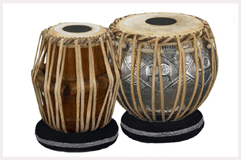 The Tabla takes its name from Tabla of Arabic origin. The general meaning of the term Tabla is an instrument facing upwards, with a flat surface. Tabla makes it possible to give a Raga to music and make a rhythm .
The Tabla takes its name from Tabla of Arabic origin. The general meaning of the term Tabla is an instrument facing upwards, with a flat surface. Tabla makes it possible to give a Raga to music and make a rhythm .
We at Utkal Sangeet Mahavidyalaya make it possible for students to become Masters in Tabla Badan.
^ Flute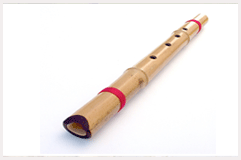
Bansuri is a very sensitive instrument. Almost all the delicate graces, curves, embellishments and shades of classical music can be performed to perfection upon it. The highest order of music can be played on this instrument, and its resonance in mandra saptak (lower octave) leaves a rare charm in the minds of its listeners. Being a portable instrument, it can be carried easily from place to place and climatic changes have very little or no effect on the seasoned bamboo.
At Utkal Sangeet Mahavidyalaya we train students to combine Music with Flute.
* Sitar
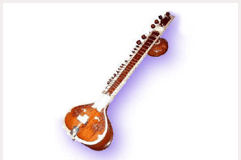 Sitar is the most popular instrument in Hindustani music. The structure and tonal quality of the modern sitar is a result of several years of hard work and devotion put in by artists and craftsmen. Craftsmen of Calcutta need special mention for their contribution to the making of a structurally perfect instrument. The basic technical and physical principles of the sitar are just like those of the veena, but the sitar is easier to handle and is more portable. For centuries, the sitar has undergone a sea of transformation, and has improved beyond recognition. The twentieth century can be called the golden era of the sitar. Stalwarts like Ravi Shankar, Vilayat Khan, Nikhil Banerjee, Uma Shankar Misra, Abdul Haleem Jaffar Khan, Rais Khan and many others have carved a special niche for the instrument in the world of music.
Sitar is the most popular instrument in Hindustani music. The structure and tonal quality of the modern sitar is a result of several years of hard work and devotion put in by artists and craftsmen. Craftsmen of Calcutta need special mention for their contribution to the making of a structurally perfect instrument. The basic technical and physical principles of the sitar are just like those of the veena, but the sitar is easier to handle and is more portable. For centuries, the sitar has undergone a sea of transformation, and has improved beyond recognition. The twentieth century can be called the golden era of the sitar. Stalwarts like Ravi Shankar, Vilayat Khan, Nikhil Banerjee, Uma Shankar Misra, Abdul Haleem Jaffar Khan, Rais Khan and many others have carved a special niche for the instrument in the world of music.
* Violin
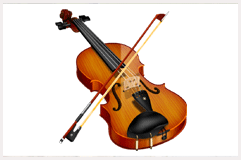
The origin of the violin is hard to trace. It underwent an extremely slows process of crystallization. Several instruments contributed to its formation. Fiddles, which were very common in Europe till the thirteenth century, and even later, bore some early features of the violin - they were always held on the shoulder and bowed palm downward, the bulging soundboard with depression near the outline, the projecting edges, the lateral pegs and even the four strings, which were combined together, in the end of the fifteenth century. The medieval time so became an important factor in its evolution.
At Utkal Sangeet Mahavidyalaya we teach Classical Hindustani Violin.
* Mardala (Pakhawaj)
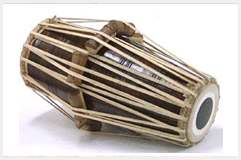
Drum is an instrument in which sound is produced by a membrane stretched and tightened over the opening of either a frame or a hollow body of any shape. Avanaddha, Anaddha, Vitata, etc., are the synonyms used for membraphonic instruments in India. Since the term drum has become a generic word used for each and every type of rhythm instrument, Avanaddha vadya of India can also be called drums. Percussion is another term which can also be used in a broader sense. From times immemorial, we also have another classification, which is used in broader sense, i.e. laya vadya the rhythm instruments and swar vadya the melody instruments.
Laya vadya are the instruments used for rhythm. They are the earliest musical instruments known to human history. Laya vadya have enjoyed a certain status in India. Drums are of various types and have been classified on the basis of their position of play, their shape and structure, the material used for their making, skins or heads, and finally the manner of playing. In India since the ancient times drums have been classified on the basis of their shapes. If we go by their shapes, we can divide Indian drums into three: - Tubular Drums, Kettle Drums and Frame Drums.
At Utkal Sangeet Mahavidyalaya we teach Mardala |
| |
| * Department of Dance |
* Chhow Dance Of Mayurbhanj
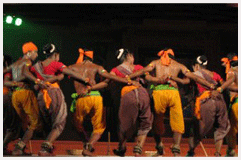
Mayurbhanj Chhau dance is prevalent in the south-eastern part of Odisha. Adjacent to the state of Manyurbhanj, lie the states of Seraikala and Purulia, today part of the States of Jharkhand and Bengal respectively. Within the region there is a large variety of tribes who, in turn, share many common features with the tribes of Madhya Pradesh and Bihar. These tribes range from the Munda group to the Austric and the India, even if anthropologists differ on the classification.
Agriculturally, many of the tribes of the region are shift cultivators and some are tool agriculturalists. Many propitiation rites are common to this tribal group of people, and the agriculturists, in particular, have rites which revolve around the installation of a pole as a symbol of fertility. The Mayurbhanj Chhow dance is the traditional legacy of Odisha.
Utkal Sangeet Mahavidyalaya has started this department to propagate and groom future dancers for the state.
* Odissi Dance
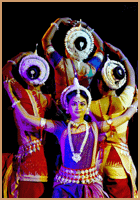
Indian classical dances today embody a sense of ecstasy and poetry. Classical dances portray aesthetic geometric patterns. This kind of perfection is derived through expressiveness of the dancer and of firmly controlled practice. These Indian classical dances are the products of lingering research by eminent maestros and performers. They drew their basic elements from the already existing dance form and surrounding environment. They created a different era in the art where the communication was only enjoyment that too of the ethereal world. The dance, that stands as it is today, imbibes its characteristics from literature, traditions, religious ceremonies and other most common activities of human and animal life. Thus the Indian classical dance can be defined as "Visual sculptural poetry enacted to enliven man's innermost latent spiritual emotions". This kind of emotional extravaganza was analyzed by the great rhetoricians of ancient India as 'Rasa'. This word elevates Indian dancing to a spiritual level from the normal recreational level. Thus we can find a keen similarity of this exquisite Indian classical dancing with Hatha Yoga of sages.
Odissi dance wasversatileas an Indian Classical dance in the year 1972. After that it has crossed international borders. |
| |
| * Department of Drama (Theatre) |
The Department of Drama was started in 1976 to trained students in modern Oriya theatre.
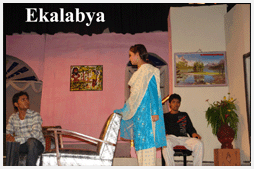 i. Stage craft
i. Stage craft
ii. Acting Theory
iii. Direction |